1980/2010 Giovanni Imbalzano Lulu © La magica storia della Santa Sindone
Dall'inizio dei secoli
Certificato dai Tre Re, Santa Nouné, Taddeo e Tommaso, Pietro e
Luca, Matteo e Giovanni, Giuseppe d'Arimatea e Maria di Betania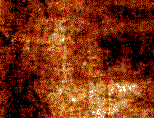
![]()
«Un giovanetto però lo seguiva, rivestito soltanto di un lenzuolo, e lo fermarono. Ma egli, lasciato il lenzuolo, fuggì via nudo» Marco (14, 51-52)
From the first of centuries!
Pontiffs 2000 Ostensions
2° MILLENIUM: Umberto II, Emanuele Filiberto, Geoffrey de Charny, Louis IX, Baldovino II, Louis VII..!
Umberto II 1983
Lanciano, 1970 / 1981: le analisi sull’Ostia, che nel VII secolo si trasformò in un tessuto miocardico, rivelano sangue di gruppo AB, come anche per la Sindone di Torino e per il Sudario d’Oviedo (1982-1999).
Turin, 1959: the “International Centre of Sindonologia” publishes first number of the journal SINDON, official organ of the C. S. I.
![]() Montecassino, February 1944:
the Allied Forces, to the term of II the War, they launch bombs on Montecassino
and the Shroud
remains in except "miraculously" because in the 1939 the definitive decision,
taken to secretly, was for the hideaway in the Sanctuary of Montevergine
(Avellino) and not up there like in first intention.
In the meantime, is born in the city already free of Reggio Calabria
the poet, physicist, mathematician, computer science
expert and "sindonologo", author of these NEW searches.
Montecassino, February 1944:
the Allied Forces, to the term of II the War, they launch bombs on Montecassino
and the Shroud
remains in except "miraculously" because in the 1939 the definitive decision,
taken to secretly, was for the hideaway in the Sanctuary of Montevergine
(Avellino) and not up there like in first intention.
In the meantime, is born in the city already free of Reggio Calabria
the poet, physicist, mathematician, computer science
expert and "sindonologo", author of these NEW searches.
![]()
Turin, 1937: the Confraternita del Santo Sudario found the association “Cultores Sanctae Sindonis” in the 1959 renamed
“Centro Internazionale di Sindonologia”.
Turin, 1898/1931: with the NEGATIVES of S. Pia and G. Enrie, the scientific searches on the Shroud have begin.
Turin, 1898: C. Cussetti executes for Umberto I King a famous copy of the Holy Shroud.
Turin, 1811: Napoleon, after is nominated himself Italy king (1805) encircling himself with the "iron crown", loosens the "Brotherhood of the Holy Shroud" founded in the year 1598. The Shroud escapes a serious danger with the defeat of Napoleon in Lipsia (1813) and the following Restoration. Victor Emanuel I of Savoia, the king of Sardine, repurchases the Piedmont and the Liguria. The Brotherhood can continue with various well-deserving works, until all today.
Genoa, 1706: there Savoia family shelter, with the Shroud, so escaping a short siege of French's against Turin.
Naples, 1652: in the Carmel of SS. Joseph and Therese (Mounts of Ponti Rossi) there is a “contact copy” of the Holy Shroud with the inscription
“Omni dimensione simillimum… contactu Prototypi consecratum Archiepiscopi manu”.

Moncalieri, 1634:
to the Carmel of Saint Joseph a “contact copy” of the Holy Shroud is
devolved from the near city of Turin.
Dal negativo fotografico, a fianco del bacino è appena visibile la riproduzione di tre piccole "bruciature" antecedenti l’incendio del 1532.
Guadalupe, 1568: the Monastery of Virgin (Spain) acquire a “contact copy” of the Holy Shroud with the registration
“pictura... die castello di Chambéry… distesa dissopra... 1568”.
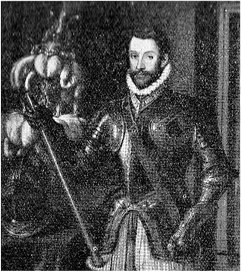
He opted instead for a wonderful career military and has transferred the Shroud (Shroud) in Turin (1578) but has also ordered an Exposition of the Shroud in Piedmont in 1535. The "Pietà di Michelangelo" (Florence 1545) reproduces the anatomy and bandaging, like the Shroud, very visible in my Dynamic Preview.
I propose you to compare the centre of the Judgement in the Sistine Chapel (1541) with the Deity of Knowledge.
![]()
From 1453 to 1535, the Shroud was in Chambéry, where may have been studied by Leonardo da Vinci (born in 1452,
and in France about to the 1507-1519).
Lier, 1516: there is a copy of the Shroud with "Poker Holes", see Information of the Pray Codex.
Savoia 1535 Ostensions
Charny 1355 Reappearance
![]() Varna, 1444: in Bulgaria, the last sheaf of Crusaders succumbs to the Ottomans and the Europe it loses the accesses to the Orient, but we prepare the New World (1492).
Varna, 1444: in Bulgaria, the last sheaf of Crusaders succumbs to the Ottomans and the Europe it loses the accesses to the Orient, but we prepare the New World (1492).
![]()
Lateral strip of the Sindone, probably re-sewed in order "to centre the image" at Edessa, city supplied of expert weavers, like the same
Patriarch Bar Aggai (disciple of Thaddaeus) before the Arabic occupation of the 641; from the angles (excluded the striscetta low on the left,
used for the improbable analysis-C14) Baldovino II has cut out some fragments and he donated these to king of France Louis IX (Byzantium, 1247).
In 1345 (one hundred years before Leonardo da Vinci) the family de Charny has carried via all the rest,
so as other French had divided themselves the Relics of Thaddaeus
(1096-1099)
.
"They look to me and they observe to me: they divided my dresses, on the my garments they throw the fate" (Psalms 22,19)
In the 1228 Baldovino was merely eleven years old and he became emperor under the protection of Jean de Brienne, of which he will marry the daughter Marie; between 1216 and 1237, Nargeaud and Philip de Touchy (from 1228) were the effectives regents of Constantinople.
In 1249, Louis IX conquered Damietta (Egypt) and Baldovino II, to the extreme of finances, went and selled to him other relics, after have lost also the pledge of a "crown of thorns" (then destroyed during the French Revolution).
Up to here, does not exist some bequest of the Shroud to the King of France.
Indeed until 1296 it is only documented a Shroud piece ("pars sindonis") guarded in the St. Chapelle de Paris; furthermore, also a false Shroud existed in Besançon, gone then in fire in 1349, already to Athens in 1205 disputatiously confused with that authentic. In 1261 the Byzantium Emperor was defeated by Michael VIII Paleologo and ran away to the Venetian island of Negroponte (Eubea); neither the family of Counts de Brienne could help him as before, because just in 1257 were dead in Egypt their Walter IV. After a pause to Athens, he lands in Puglia then he goes in France and then he returns in Italy from Charles de Anjou, French extremely nationalist, brother of Louis IX. In 1267, with the treaty of Viterbo he surrenders the Epirus and the Acaja to Charles in exchange for the reconquest, never happened, of Byzantium. In 1273 Baldovino marries Filippa Beatrice, daughter to Charles, in Foggia and here he dies after a few days.Of the Shroud there is only a trace next to the Gargano, in the Cistercian Little Island of S. Nicholas (Tremiti): the crucifix, certainly Shroud-like, but with the physiognomy of the emperor, of the year 1270 for Garrison, in the Sanctuary S. Maria (work of Oriental influence that was executed on a pre-existing cross, perhaps from a Benedictine).
From Marguerite de Charny and Jean de Joinville, daughter of a famous journalist friend of Louis IX, Geoffroy is born in 1305. He married a lady Joan, descendant of the nobles de Touchy of Byzantium, and after her death, he married in 1340 Joan de Vergy, lady of Lirey(in Champagne, between Joinville and Paris) and grandson of Othon de la Roche, who translated in 1208 the (false) shroud of Besançon from Athens. In 1345 he depart with mans of France and Italy (of Venice, Cyprus, and Hospitallers of Rhodes) for a sortie to Smyrna but, at first, is wintered in Negroponte. He return in 1347 depositing the loot in the hands of Philip VI of Valois. Geoffroy de Charny was remunerated from King only in 1349 with some relics, including the Shroud, described in her time as not much precious! The Shroud was not found in Izmir, where has gone Geoffroy only to fight, nor in Athens, where the citizens deplored already at first the loss of one (false) Shroud: in effect it was in hands to the King of France, maybe taken in somebody of the Italian territories, crossed by Baldwin II in his last twelve years.
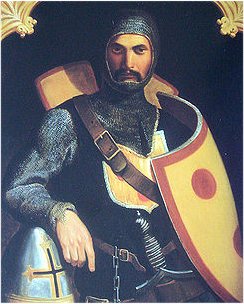 Baldovino II
Baldovino II  Croce Imperiale
Croce Imperiale 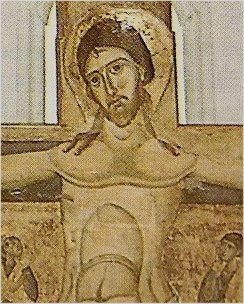
Al centro, la mano col pollice introverso, come sulla Sindone
Finally, to honor the last wishes and / or for interest, in 1357 the real Shroud appears publicly in a church Lirey already in construction from the 1356 and entrusted by Geoffroy de Charny to his nephew, William de Touchy.
NOTE The foundation of the Church dates to 1353, Innocent Pope has anticipated the indulgences for pilgrims in 1354, but in 1389 the Bishop Pierre d'Arcis controversially has recalled for the visibility of the sacred cloth in 1355 in advance, before the actual Consecration of the Church. However, in the 1390 also Pope Clement VII confirmed permissions and indulgences for the veneration of the Shroud of Lirey; and no doubt this is the same Shroud already visited in 1192 from the French royals.
Plate of the French Ostensions, with the Charny/Vergy coats of arms:
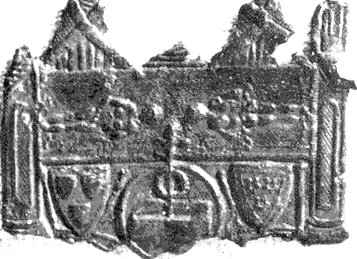
 Pray Codex brings two times the Tricerium, here also on the Crux;
Pray Codex brings two times the Tricerium, here also on the Crux;
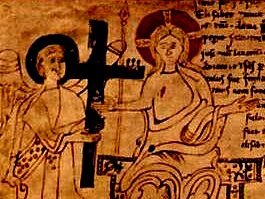 a second Angel indicate the stigma
a second Angel indicate the stigma
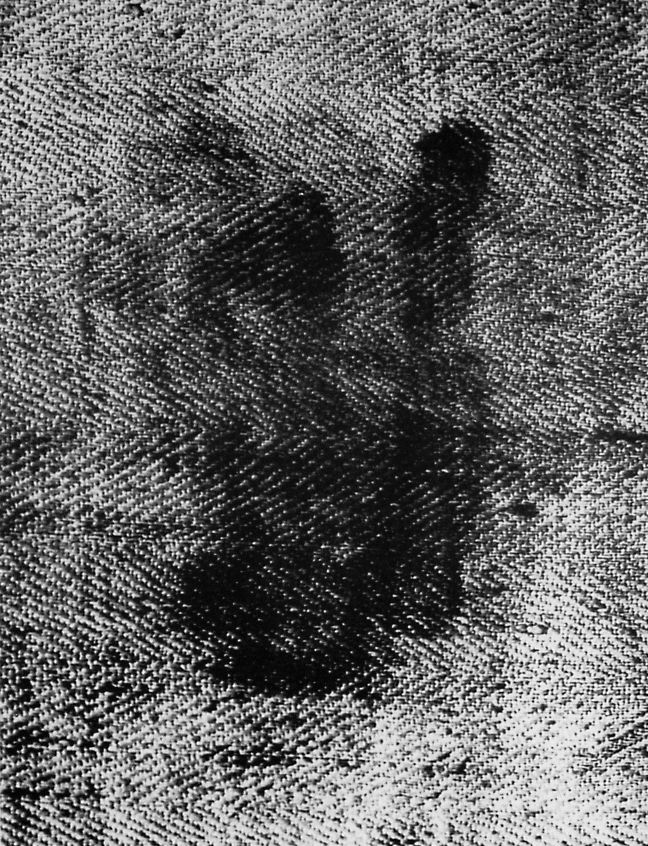 cY:
cY: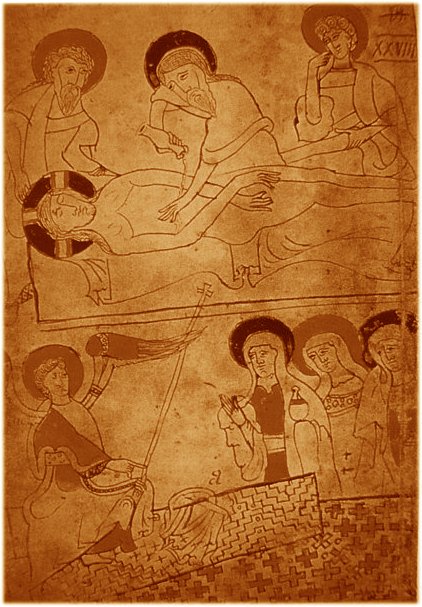
"Lord, looks from the sky and sees, he visits this vine, and ago that it prospers because your right has planted this!"
The Christ has the stigmas on the "right" wrist, the eye damaged as covered by a small coin, the folds of the tunic follow the linen of the chin rest, how to it stands out directly from the "positive" photo of the shroud; also the feet are bloody in an asymmetrical manner. The ritual Bizantine, derived from liturgic use of IV century (Antioch) was diffused in Constantinople with the influence of the monks and of the emperor until the IX century, how to in the actual Orthodox ritual. According to author, a Tricerium has produced a kind of burns in the shape of "L" (3 in horizontal and 2 vertical) on the Shroud imperfectly refolded in 4 parts. These and other important signs are brought back into the
in the 1192 / 1196, and they do not have nothing to that to see with the fire of Chambéry, as show the reproduction of the "L" precedent to 1532, for example before year 1516 the copy of Saint Gommeire (Lierre, Belgium) was venerated also to Chambéry. Even if the burns were procured on purpose, they can be dated
after the 381 (I Council of Constantinople on the Trinity) or the 451 AC: I Council of Chalcedony on the DUALITY of Christ (in an unique person). In such date, happening the Schism of Monophysites, the possessors of the Shroud (in Edessa in the 544 AC, as specified more ahead).These were a lot reluctant to show the Shroud, also for the presence of the Muslims, but in the 944 was transferred to Byzantium by Constantine VII; consequently, considering the importance given to the burns to "L" only towards the Millennium, we can consider that own in such date they were particularly observed. The Codex was transcribed under the reign of Hungarian king (1173-1196) Bela III, husband of Marguerite, very cultured sister of Philip II, King of France. Whereas Byzantium was center of the army for the III Crusade (1189-1192) Philip II have could well know the Shroud, boast of the Byzantine emperors.
Without do from there a mystery, already his father Louis VII had admired the Shroud in 1147, from Manuel Komnenos, at the beginning of the II Crusade, according to G. Cinnamon (History of G. Komnenos, Migne, Patrologia Graeca CXXXIII); and Almaricus, Latin King the Jerusalem, he did just the same (William of Tyros, 1171).
XI century
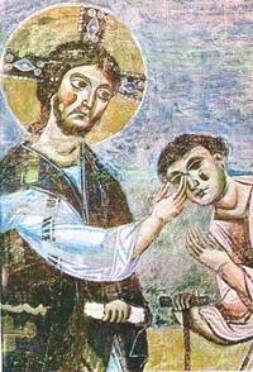 cY
cY 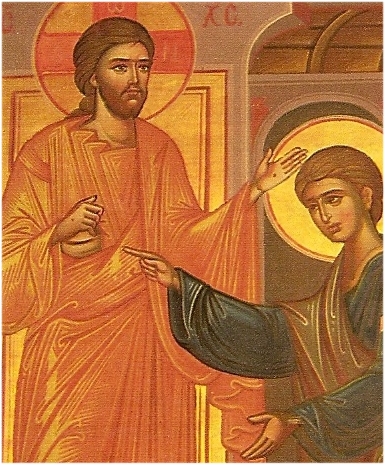
LEFT (Sant'Angelo in Formis): cure of the blind person, curl with 3 tips (see blood in forehead of the Shroud) and the prime wound on the wrist.
RIGHT (Thessalonika mosaic): similar to the latter and to the Pray Codex.
Comneni Dynasty 1192 Pray Codex
1° MILLENIUM: Constantine VII, Omar I, Baradeus, Bar Daisan, Mar Aggai, Abgar V..!
Constantinus VII 944 Coins
